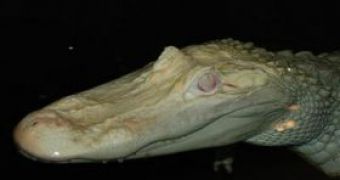You may have heard about white tigers, but white ... alligators!?...
Yes, they do exist and are almost impossible to be found in nature as they would be extremely vulnerable to predators or the sun. Around US, there are 50 albino individuals. One albino 12-years old female is exposed at the Knoxville Zoo.
An albino lacks or has an inhibited gene for melanin, the brown pigment from the skin and eye's iris, that's why the alligator's skin appears white and her eyes pinkish (due to the blood vessels).
The visitors must enter a dark lobby to see the gator, as the sun could burn its skin.
The animal is still for hours and occasionally, the movement of one eyelid would reveal an inner membrane (extremely reduced in humans) that makes the eye appear milky. The most common question put by visitors is "Is she real?" said Phil Colclough, assistant curator of herpetology at the zoo.
"Nobody believes she's real. They stare until she takes a breath or moves her eyes or jumps in the pool."
Some white alligators are leucistic and this produces small amounts of melanin, that's why their eyes are blue.
Knoxville's alligator is loaned from the Alligator Farm Zoological Park in St. Augustine, Florida, which possesses about 30 animals, got in the last 15 years from a commercial farm in Cut Off, La.
"The albinos are found in the same nest every year and are believed to be produced from the same male and female who both carry the recessive gene for albinism," said David Kledzik, curator of reptiles in St. Augustine.
"The Florida park made a deal with the farmer to get the albinos. He hatches and raises them until he is ready to give them up," he said.
The Florida zoo also delivered albino alligators to the Columbus Zoo and Aquarium in Ohio.
"The public likes them a whole lot. I've been here 12 years, and hardly a week goes by that someone doesn't ask where the white alligator is that was here 10 years ago." Colclough said.

 14 DAY TRIAL //
14 DAY TRIAL //